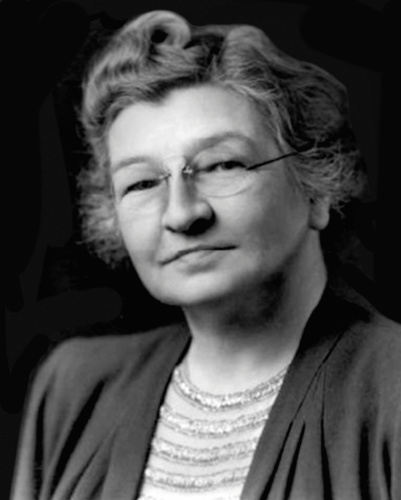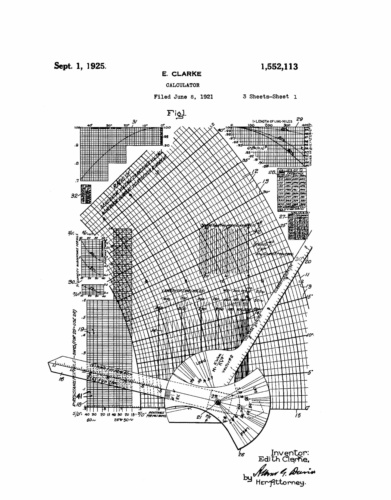Almost a century ago, on 9th February 1926, the New York Times ran with a story headed ‘Woman Addresses Electrical Institute’. Drawing further attention to the significance of the occurrence described, the newspaper further explained: ‘Miss Edith Clarke the Only One of Her Sex to Read a Paper at Engineers’ Meeting.’ The first woman to be professionally employed as an electrical engineer in the United States was literally headline news.

In fact, the delivery of one of her numerous influential papers on electrical power systems was but one of many firsts in Clarke’s remarkable career. She was the first female professor of electrical engineering in the US, the first woman fellow of the American Institute of Electrical Engineers as well as the first woman to be recognised by the oldest engineering ‘honor society’ in America, Tau Beta Pi. Her 1943 book Circuit Analysis of A-C Power Systems is a classic of its kind, occasionally cropping up on rare book collectors’ websites with a price tag of several hundred pounds. Today, perhaps Clarke’s best-known contribution to the world of engineering is her graphical calculator that greatly simplified the calculations necessary to determine the electrical characteristics of long electrical transmission lines, for which she was inducted posthumously to the National Inventors Hall of Fame in 2015.
Not much is known of Clarke’s childhood other than it was extraordinary. Daughter of a wealthy farm-owning lawyer and one of nine children, she was born in 1883 during a time of economic recession, and when the great engineering landmarks were the opening of the Brooklyn Bridge and Edison’s first overhead electric lighting systems. As a child, she had difficulties with reading and spelling, but showed an exceptional aptitude for mathematics and had a passion for card games, particularly whist. By the time she was 12, the young Edith was an orphan, with the responsibility of her upbringing being placed on an older sister.
Despite resistance from her relatives, Clarke invested her inheritance in acquiring an education. She enrolled at Vassar College where (because there was no provision to teach engineering to women) she took her Bachelor of Science degree in mathematics and astronomy. After graduating she became a teacher of mathematics and physics (first at a private girls’ school in San Francisco and then at Marshall College in West Virginia), but became disillusioned after realising, as she later recalled, that “teaching is not at all like a game of Duplicate Whist! I therefore turned to something else.”
That ‘something else’ was of course engineering, and Clarke duly enrolled in the civil engineering programme at the University of Wisconsin in 1911. A summer placement as a mathematical computing assistant at AT&T in New York led her to change direction again, taking the decision to remain full-time, where she would eventually become the manager of a group of women ‘computers’ who made calculations for the Transmission and Protection Engineering Department during the First World War. Ever willing to travel, she also studied radio at Hunter College and electrical engineering at Columbia University.
“There’s always a demand for anyone who can do a good piece of work.”
Edith Clarke (1883 - 1959)
At the end of the war in 1918 Clarke decamped to the Massachusetts Institute of Technology, where she became the first woman to earn a master’s degree in electrical engineering. Supervised by the electrical engineer Arthur E Kennelly, her thesis was entitled Behavior of a lumpy artificial transmission line as the frequency is indefinitely increased. Her next career step was to take a position at General Electric where she was to work for the following quarter of a century, with the exception of two years spent on leave as a professor of physics at the Constantinople Women’s College in Turkey, before returning to GE in 1922 as a salaried engineer.
Part of the purpose for this career hiatus was to highlight her irritation at the lack of career opportunities for women and to draw attention to gender pay inequality. As a woman, Clarke neither earned the same salary nor was afforded the same professional status as her male colleagues. Later in her career, as a leading woman engineer of her day, she was to tell the Dallas Morning News: “I had always wanted to be an engineer, but felt women were not supposed to be doing things like studying engineering.”
One of the defining moments in Clarke’s career happened on 8th February 1926 when, as the first woman to deliver a paper at the annual midwinter convention of the American Institute of Electrical Engineers (AIEE), she demonstrated the use of hyperbolic functions for calculating the maximum power that a power line could carry without becoming unstable. Although the main reason this attracted national media attention was undoubtedly Clarke’s gender, there was also the matter of reporting on a solution to a problem in America’s critical national infrastructure. Geographical penetration of the American power grid meant that transmission lines were getting longer, leading to greater loads and the increased likelihood of instability in the supply.
Responding to the fact that the mathematical models available at the time applied only to small systems, Clarke set about modelling larger-scale systems by using the ‘method of symmetrical components’ mathematical technique. This level of mathematics employed by Clarke would have been seen as esoteric by most electrical engineers of the day, and so to simplify and reduce the laborious calculations that went into resolving issues associated with larger power systems, Clarke translated her approach into a kind of ‘ready reckoner’.
At a time when systems were rapidly increasing in size and complexity, Clarke’s graphical calculator was making the everyday lives of the electrical engineer much easier. These new methods for the analysis of complex systems were arguably the first tentative steps towards what we know today as smart grid technology.

During her time at General Electric, Clarke was also a prolific writer, publishing 18 technical papers as well as the much-respected book Circuit Analysis of A-C Power Systems (the second volume of which was published in 1950) that was a required reading on the topic for decades in engineering schools and colleges. This seminal textbook includes adaptations of her lectures on the αβγ transformation for simplifying the analysis of three-phase circuits, later to become known eponymously as the Clarke Transformation. Another of her papers, co-authored by Clarke and published in 1941 in the Transactions of the American Institute of Electrical Engineers, received an award from the AIEE for being the first published mathematical examination of transmission lines more than 300 miles long. This distinguished publishing aspect of her career propelled Clarke to become recognised as an authority on the manipulation of hyperbolic functions, equivalent circuits, graphical analysis and electric power systems.
Her citation in the National Inventors Hall of Fame draws attention to an often overlooked segment of Clarke’s career in which worked on the design and development of hydroelectric dams in the West Hoover Dam, contributing her electrical expertise to the installation of turbines that generate hydropower there to this day.
In 1947 Clarke left General Electric with the intention of retiring. In fact, she made a comprehensive return to her roots and bought herself a farm in rural Maryland, only to come out of retirement two years later to teach in the faculty of electrical engineering at the University of Texas, Austin. It was here that she left another mark on the history of engineering by becoming the first female professor of electrical engineering in the US, and where she was still critically aware of women’s lack of representation in her field, telling the Daily Texan in 1948: “There is no demand for women engineers, as such, as there are for women doctors; but there’s always a demand for anyone who can do a good piece of work.” Clarke eventually withdrew from academia in 1956 and spent the remaining three years of her life on her farm, where she died of a heart attack in 1959 at the age of 76.
In his paper From Computer to Electrical Engineer – the Remarkable Career of Edith Clarke, Dr James E Brittain says that as a woman working in an environment traditionally dominated by men, “she demonstrated effectively that women could perform at least as well as men if given the opportunity. Her outstanding achievements provided an inspiring example for the next generation of women with aspirations to become career engineers.” Clarke was honoured with listings in Who’s Who in Engineering, American Women, Careers for Women, Women Can Be Engineers and also, as if to bear witness perhaps to how little prepared the establishment was to accept a woman engineer of such high accomplishment, Men of Science.




Swiss geoengineering start-up targets methane removal
No mention whatsoever about the effect of increased methane levels/iron chloride in the ocean on the pH and chemical properties of the ocean - are we...